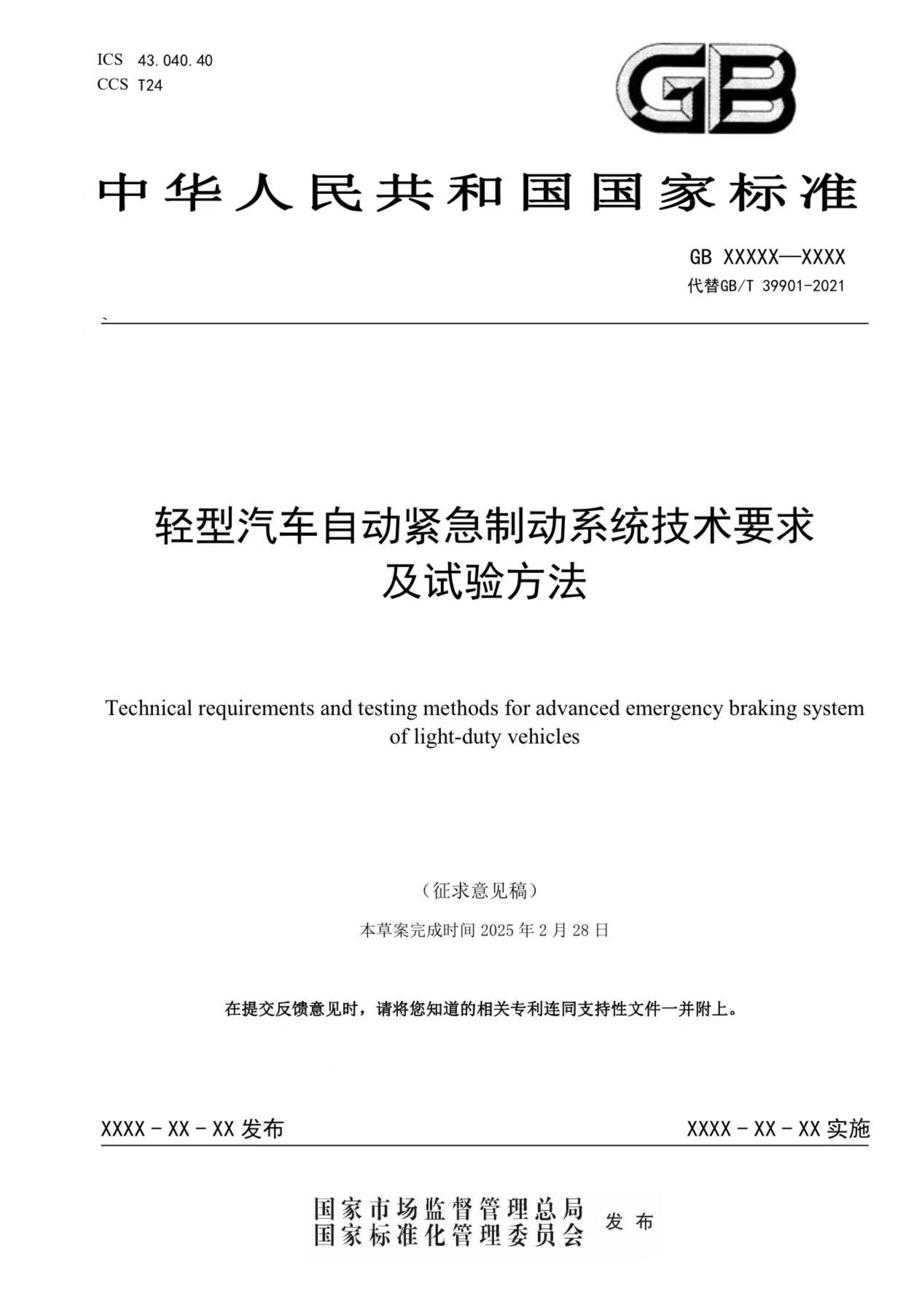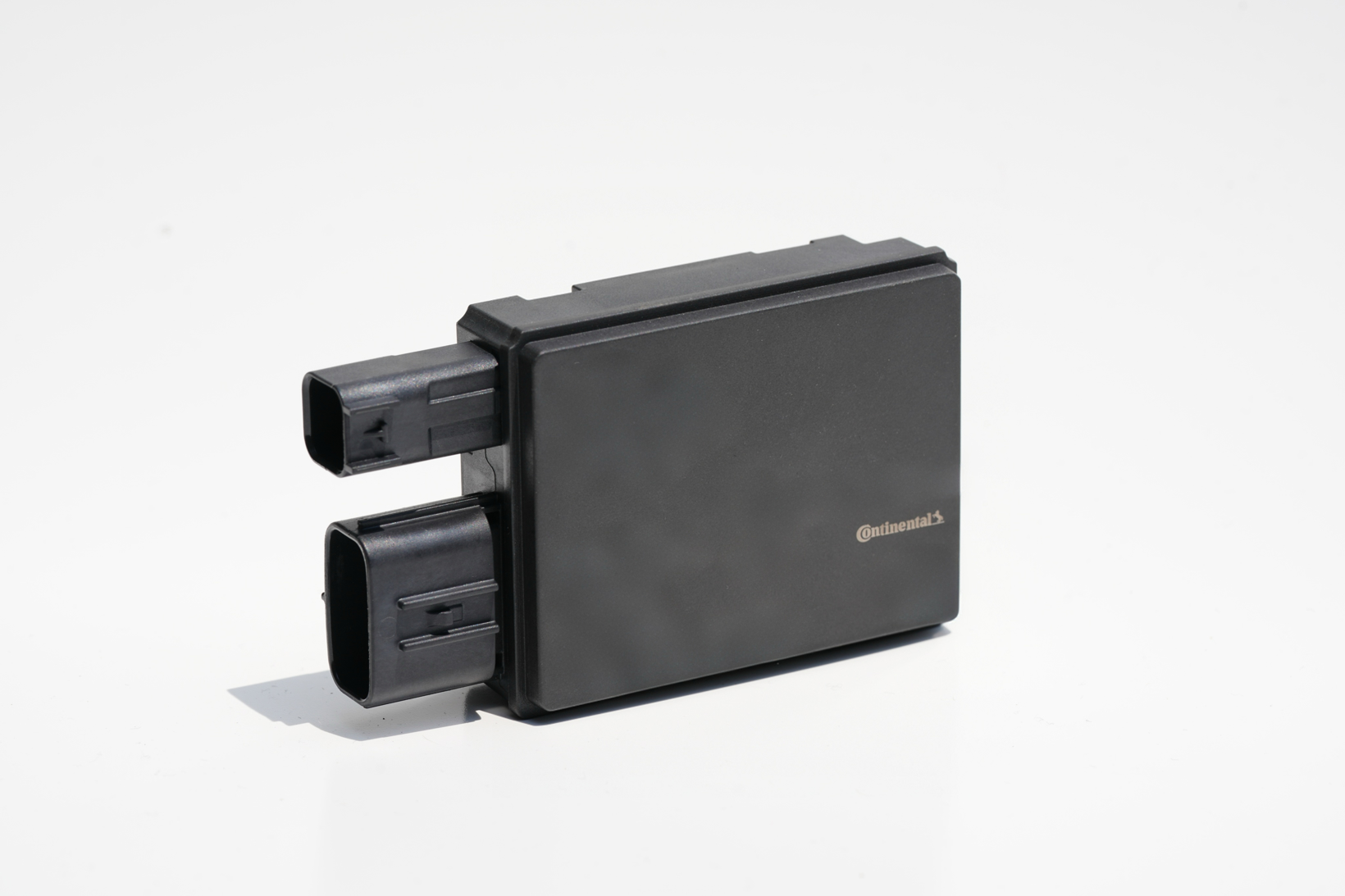New national standard implemented, single radar aeb solution aids in safety equality
A new regulation has once again brought AEB to the center of public discussion. Who would have thought that the AEB function, which had been a subject of constant debate, would become standard in cars?
The consultation phase for the highly anticipated mandatory national standard "Technical Requirements and Test Methods for Automatic Emergency Braking Systems of Light Vehicles" (hereinafter referred to as the "new national standard") has recently concluded. This standard will replace the current national standard GB/T 39901-2021 and is scheduled to be officially implemented on January 1, 2028.
The new national standard has been upgraded from the current recommended national standard to a mandatory national standard, requiring M1 and N1 category vehicles to be mandatorily equipped with an automatic emergency braking system (AEB). As the safety requirements are upgraded, the range of covered vehicle models has also been expanded.Turning "recommended items" into "mandatory items," the new national standard puts a technical issue on the negotiation table of safety equality: safety should not be a privilege for only some vehicle models.

Image source: National Public Service Platform for Standards Information
The arrival of the new national standard also brings new challenges to the AEB industry chain. According to data from the China Passenger Car Association, from January to April 2025, the overall AEB installation rate for passenger cars in China reached 60.1%, while the AEB installation rate in the new energy passenger car market reached 64.3%. Although the AEB standard configuration rate for new cars in China is nearly 60%, there is still a 40% gap that needs to be filled.
Fortunately, as the countdown to the implementation of the new national standard begins, some suppliers in the industry have introduced a single radar AEB (Automatic Emergency Braking) solution. This solution achieves the optimal balance of the "impossible triangle" of technology, safety, and cost, using a single millimeter-wave radar to make safety accessible to the widest range of drivers.
The ultimate goal of "safety equality" is to ensure that every car has the same millisecond-level braking determination in critical moments.
Countdown to the New National Standard: AEB Transitions from "Whether It Exists" to "Is It Sufficient"
Automatic Emergency Braking (AEB) is an automotive active safety technology.
Based on perception devices such as LiDAR, millimeter-wave radar, or ADAS cameras, detect potential collision risks with vehicles, pedestrians, or other road users ahead, and automatically trigger actuators through the system to apply braking in order to avoid collisions or mitigate the severity of collisions.
The new national standard has been upgraded from a recommended standard to a mandatory standard, bringing about the most core change of making the installation of AEB shift from "whether it exists" to "whether it is adequate." Especially in terms of safety, in addition to requiring mandatory installation of AEB in vehicles, many new requirements have also been proposed.
Overall, the new national standard introduces three core changes. First, the range of applicable vehicle models has been expanded. According to the new standard, all M1 category passenger vehicles (sedans, SUVs, MPVs, etc.) and N1 category light-duty trucks (with a total mass of ≤3.5 tons) are required to be equipped with AEB systems, which will cover over 90% of light-duty vehicles in China.
Secondly, the technical requirements have been comprehensively upgraded. The new national standards add requirements for the recognition capabilities of vulnerable road users such as pedestrians, bicycles, and scooter-style two-wheeled motorcycles, and include tests for complex scenarios such as intersections and right-turn following.
At the same time, the new national standard requires that the pass rate for vehicle-to-vehicle tests should not be lower than 90%, and the pass rate for vehicle-to-pedestrian/bicycle tests should not be lower than 80%. This standard is not only higher than the current recommended national standard but also aligns with the EU's UN-R152 regulations.
Thirdly, there has been a significant improvement in performance indicators. The new national standards have introduced new requirements for the upper and lower speed limits at which AEB (Automatic Emergency Braking) is triggered. M1 category passenger cars are required to have their AEB systems activated within the speed range of 10 km/h to 80 km/h, while N1 category vehicles must have theirs activated within the range of 10 km/h to 60 km/h.
In addition, for stationary lead vehicles, the test vehicle (M1) speed has been increased from the old national standard of 30 km/h to 80 km/h, and it is required to completely avoid collisions at a speed of 40 km/h. The deceleration rate during braking must not be less than 5.0 m/s², compared to the previous standard of 4.0 m/s². For slow-moving vehicles ahead (speed of 20 km/h), the test vehicle speed has been increased to a maximum of 80 km/h. For vehicles ahead that are braking (speed of 50 km/h), the distance between the two vehicles is 40 meters.
On the other hand of the new national standard is the "three major challenges" that AEB needs to overcome. According to data from the China Passenger Car Association, the AEB installation rate for new cars in China is around 60%. So, why are 40% of new cars not yet equipped with AEB as a standard feature?
Currently, the industry needs to address three issues for AEB to be fully popularized in the future. First, the cost barrier. Taking the single-camera solution as an example, although the cost is already very low, adding calibration, brackets, and harnesses still increases the cost, making the assembly cost still high for models that pursue cost-effectiveness. We observe that for models priced around 80,000 to 100,000 yuan, the AEB installation rate is very low.
2. The challenge of reliability. For instance, let's consider a purely vision-based AEB (Automatic Emergency Braking) system, which primarily relies on cameras for sensing. The performance of cameras drastically declines in conditions such as rain, fog, backlighting, and nighttime, leading to false alarms or missed detections. As a result, manufacturers are reluctant to place the entire "accident liability" on vision algorithms.
3. Technical Challenges: The AEB system is not simply an "add a sensor" equation, but rather a full-chain coupling of "perception-decision-execution". The development and optimization of the AEB system require high-level collaboration and tight coupling. Any weakness in a single link could affect the performance and safety of the entire system.
With the arrival of the new national standards, AEB has transformed from an "extra credit feature" to a "life-and-death mandatory question." There is an urgent need for a "cost-effective and reliable" new solution for models that require the addition of AEB.
Single radar AEB solution: Putting technical strength into one millimeter-wave radar.
The introduction of the new national standard has brought new challenges and opportunities to the automotive safety industry. In the current market, which is filled with various "pseudo-AEB" solutions, the new national standard poses higher requirements for suppliers of assisted driving solutions, including technical research and development capabilities, product reliability, cost control capabilities, and the ability to achieve large-scale mass production.
Continental, with over 25 years of experience in millimeter-wave radar technology and extensive system development expertise, has conducted in-depth localization development to meet the needs of the Chinese market. Recently, they launched a cost-effective single radar AEB solution that fully complies with the new national standards.
This is not only a perfect fit for regulatory requirements but also a model of the triple balance of technical strength, safety performance, and cost-effectiveness.This solution minimizes hardware costs, allowing consumers to enjoy a safer driving experience without bearing excessive expenses. Meanwhile, it maintains performance without compromise, helping automakers fully meet regulatory requirements and continuously maintain market competitiveness.

Image source: Continental AG
First of all, this is attributed to the adoption of the scheme. Continental's high-performance sixth-generation forward millimeter wave radar ARS620.
The single radar AEB solution utilizes the primary advantage of millimeter-wave radar, which is all-weather operation. Compared to the other common single-camera solutions, the single radar solution is unaffected by lighting conditions and adverse weather. Whether driving at night, in heavy rain, fog, or other complex environments, this solution can maintain the efficient and stable operation of the AEB system. This reliability can save lives at critical moments, providing drivers with comprehensive, round-the-clock safety protection.
Moreover, millimeter-wave radar has a second major advantage: extremely high detection accuracy for distance and speed. In this aspect, millimeter-wave radar outperforms cameras and even lidar.
The former radar ARS620 integrates several advanced technologies such as Launch on Package (LoP) technology, waveguide antennas, CCM stepped linear frequency modulation, super-resolution algorithms, and anti-jamming technology, boasting industry-leading detection performance: the maximum detection range for four-wheeled vehicles and motorcycles reaches 280 meters; for pedestrians, the maximum detection range is 174 meters; the horizontal field of view (FOV) is ±60° and the vertical field of view (FOV) is ±20°; it has vertical detection capabilities and can output height attributes of dynamic and static targets, such as passable and traversable information.
Secondly, for the single radar AEB solution, suppliers are required to have millimeter-wave radar. And mass production expert of the system Character.When it comes to fundamental safety, AEB is a system function with an extremely low fault tolerance rate. Traditional system solution providers mainly focus on the vision route, and there are very few players with mass production capabilities in the millimeter-wave radar field.
Continental has accumulated profound expertise in the radar field, having delivered 200 million radar units which provided valuable technical wealth in hardware design, antenna design, and radar signal processing. As a globally leading system solution provider, it also possesses extensive experience in system-level mass production.
The Continental Group's AEB system (such as the 1R1V system) has been globally mass-produced in numerous models including Toyota and Volkswagen. After years of market testing, its stability and robustness have been fully verified. The Continental Group has not only managed to integrate AEB into a single front radar but also managed to include the ACC (Adaptive Cruise Control) function.
Implement Equality Thoroughly: Make Security and Inclusiveness an Industry Consensus
However, the single radar AEB solution is not something that everyone can easily implement. It requires deep technical expertise, strong system development capabilities, and extensive mass production experience. Continental Group, leveraging its leading position in the radar field and its capability in system-level solutions, has successfully brought the single radar AEB solution to market, setting a new benchmark for the industry.
If technological capability is just one part of the equation, the cost advantage of the single radar AEB solution is the key to its success. Continental GroupA single radar AEB solution is very suitable for entry-level passenger vehicles that prioritize cost-effectiveness and practical commercial vehicles used for operations, effectively addressing the cost-sensitive issues of these vehicle types.
This is exactly the key market for future AEB installations. According to the detailed statistical data from the China Passenger Car Association, we find significant differences in the installation rates of AEB across different price segments: for models priced above 400,000 yuan, the AEB installation rate is 100%; for models priced between 150,000 and 400,000 yuan, the AEB installation rate is over 80%; for models priced between 100,000 and 150,000 yuan, the AEB installation rate is about 58.5%; and for models priced below 100,000 yuan, the AEB installation rate is only 6.5%.
Continental's single radar AEB solution targets the untapped market for AEB installations. By offering a low-cost, high-value solution, it helps these vehicles meet the requirements of the new national standards, achieving a breakthrough in safety technology from "nothing to something."

Image source: Continental AG
The technical orientation of the new national standards coincides with the main direction promoted by Continental AG. At the time of the new standard's release, the industry is also undergoing an intense debate about the AEB technology route. From the perspective of the entire industry, the AEB technology routes include various solutions such as millimeter-wave radar, pure vision, and multi-sensor fusion.
Through the analysis of the draft for public consultation, we found that the new national standard does not mandate the installation of specific sensors. It is evident that the new standard takes into account the characteristics of different technological paths, and thus does not specify which type of sensor must be standard. The intention is to leave more room for the development of various technological routes.
The ultimate goal of the new national standard is to make AEB standard on the vast majority of vehicle models, achieving safety equality.Continental aims to make safety technology accessible to the entire market through a single radar AEB solution, promoting the democratization of assisted driving safety.
By applying high-end radar technology to entry-level models, more consumers can enjoy safety technology that originates from high-end models. This concept of technology inclusivity not only enhances the safety standards of the entire industry but also provides consumers with tangible safety assurance.
Whether in the M1 passenger vehicle domain or the N1 commercial vehicle sector, Continental's single radar AEB solution can be customized through algorithms to fit different vehicle parameters (length, wheelbase, etc.). It can be installed on the front bumper to meet the needs of various vehicle models.
It should also be pointed out that for operational vehicle models (such as logistics vehicles and other high-frequency operating vehicles), the mandatory installation of the AEB system will effectively reduce the accident rate of operational vehicles, thereby lowering vehicle insurance costs and forming a "installation cost - premium savings" positive cycle, achieving a win-win situation.
Continental Group's new proposition for safety equity is to continuously lower the barriers to popularizing safety technology by providing low-cost, high-performance solutions, promoting the evolution of AEB from being "exclusive to high-end models" to "standard equipment for all models."
Summary of World-Class
When regulations include AEB in the mandatory list, Continental uses an ARS620 radar to tell the industry, "Technological parity is not about low price and low quality, but about using scale, experience, and system capabilities to turn the most advanced safety technologies into standard features that everyone can afford and use well.
【Copyright and Disclaimer】The above information is collected and organized by PlastMatch. The copyright belongs to the original author. This article is reprinted for the purpose of providing more information, and it does not imply that PlastMatch endorses the views expressed in the article or guarantees its accuracy. If there are any errors in the source attribution or if your legitimate rights have been infringed, please contact us, and we will promptly correct or remove the content. If other media, websites, or individuals use the aforementioned content, they must clearly indicate the original source and origin of the work and assume legal responsibility on their own.
Most Popular
-

List Released! Mexico Announces 50% Tariff On 1,371 China Product Categories
-

EU Changes ELV Regulation Again: Recycled Plastic Content Dispute and Exclusion of Bio-Based Plastics
-

Clariant Unveils Cost-Cutting Plan Details, Plans to Shut Down Multiple Plants
-

Mexico officially imposes tariffs on 1,400 chinese products, with rates up to 50%
-

Nissan Cuts Production of New Leaf EV in Half Due to Battery Shortage






